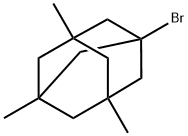2-CYCLOHEXYLETHYL BROMIDE
Synonym(s):2-Cyclohexylethyl bromide
- CAS NO.:1647-26-3
- Empirical Formula: C8H15Br
- Molecular Weight: 191.11
- MDL number: MFCD00019398
- EINECS: 216-712-1
- SAFETY DATA SHEET (SDS)
- Update Date: 2024-12-18 14:08:57

What is 2-CYCLOHEXYLETHYL BROMIDE?
Chemical properties
2-CYCLOHEXYLETHYL BROMIDE is colourless to yellow liquid
The Uses of 2-CYCLOHEXYLETHYL BROMIDE
2-CYCLOHEXYLETHYL BROMIDE is a reagent used in the cross-coupling and Grignard reactions. It is used in the synthesis of immunosuppressive agents consisting of 5-phenylalkoxypsoralens as well as agon ists for human vitamin-D resistant Rickets.
The Uses of 2-CYCLOHEXYLETHYL BROMIDE
1-Bromo-2-cyclohexylethane may be used in the synthesis of 2-cyclohexylethyloxy-4-nitroaniline.
General Description
1-Bromo-2-cyclohexylethane is a halogenated hydrocarbon. Reaction of 1-bromo-2-cyclohexylethane with pillar[5]arene has been investigated.
Properties of 2-CYCLOHEXYLETHYL BROMIDE
| Melting point: | 57°C |
| Boiling point: | 209 °C (lit.) |
| Density | 1.221 g/mL at 25 °C (lit.) |
| refractive index | 1.4900 |
| Flash point: | 96°C |
| storage temp. | Inert atmosphere,Room Temperature |
| solubility | Chloroform (Sparingly), Ethyl Acetate (Slightly) |
| form | Liquid |
| color | Clear colorless to slightly yellow |
| BRN | 1919816 |
| Stability: | Stable. Combustible. Incompatible with strong oxidizing agents. |
| CAS DataBase Reference | 1647-26-3(CAS DataBase Reference) |
| EPA Substance Registry System | Cyclohexane, (2-bromoethyl)- (1647-26-3) |
Safety information for 2-CYCLOHEXYLETHYL BROMIDE
| Signal word | Warning |
| Pictogram(s) |
 Exclamation Mark Irritant GHS07 |
| GHS Hazard Statements |
H315:Skin corrosion/irritation H319:Serious eye damage/eye irritation |
| Precautionary Statement Codes |
P264:Wash hands thoroughly after handling. P264:Wash skin thouroughly after handling. P321:Specific treatment (see … on this label). P305+P351+P338:IF IN EYES: Rinse cautiously with water for several minutes. Remove contact lenses, if present and easy to do. Continuerinsing. P332+P313:IF SKIN irritation occurs: Get medical advice/attention. P337+P313:IF eye irritation persists: Get medical advice/attention. |
Computed Descriptors for 2-CYCLOHEXYLETHYL BROMIDE
| InChIKey | JRQAAYVLPPGEHT-UHFFFAOYSA-N |
New Products
(S)-3-Aminobutanenitrile hydrochloride 4-Methylphenylacetic acid N-Boc-D-alaninol N-BOC-D/L-ALANINOL Tert-butyl bis(2-chloroethyl)carbamate 3-Morpholino-1-(4-nitrophenyl)-5,6-dihydropyridin- 2(1H)-one Furan-2,5-Dicarboxylic Acid Tropic acid 1-Bromo-3,5-Di-Tert-Butylbenzene S-2-CHLORO PROPIONIC ACID ETHYL ISOCYANOACETATE 2-Bromo-1,3-Bis(Dimethylamino)Trimethinium Hexafluorophosphate 4-IODO BENZOIC ACID 3-NITRO-2-METHYL ANILINE 1-(2,4-DICHLOROPHENYL) ETHANAMINE (2-Hydroxyphenyl)acetonitrile 4-Bromopyrazole 2-(Cyanocyclohexyl)acetic acid 4-methoxy-3,5-dinitropyridine 1-(4-(aminomethyl)benzyl)urea hydrochloride 2-aminopropyl benzoate hydrochloride diethyl 2-(2-((tertbutoxycarbonyl)amino) ethyl)malonate tert-butyl 4- (ureidomethyl)benzylcarbamate Ethyl-2-chloro((4-methoxyphenyl)hydrazono)acetateRelated products of tetrahydrofuran
![3-BROMO-7-(BROMOMETHYL)-1,7-DIMETHYLBICYCLO[2.2.1]HEPTAN-2-ONE](https://img.chemicalbook.in/StructureFile/ChemBookStructure3/GIF/CB5418464.gif)






![7-(BROMOMETHYL)BICYCLO[3.2.1]OCTAN-2-OL](https://img.chemicalbook.in/StructureFile/ChemBookStructure2/GIF/CB3749195.gif)
You may like
-
 (2-Bromoethyl)cyclohexane CAS 1647-26-3View Details
(2-Bromoethyl)cyclohexane CAS 1647-26-3View Details
1647-26-3 -
 1-Bromo-2-cyclohexylethane CAS 1647-26-3View Details
1-Bromo-2-cyclohexylethane CAS 1647-26-3View Details
1647-26-3 -
 1975-50-4 98%View Details
1975-50-4 98%View Details
1975-50-4 -
 2-HYDROXY BENZYL ALCOHOL 98%View Details
2-HYDROXY BENZYL ALCOHOL 98%View Details
90-01-7 -
 2-Chloro-1,3-Bis(Dimethylamino)Trimethinium Hexafluorophosphate 221615-75-4 98%View Details
2-Chloro-1,3-Bis(Dimethylamino)Trimethinium Hexafluorophosphate 221615-75-4 98%View Details
221615-75-4 -
 61397-56-6 CIS BROMO BENZOATE 98%View Details
61397-56-6 CIS BROMO BENZOATE 98%View Details
61397-56-6 -
 14714-50-2 (2-Hydroxyphenyl)acetonitrile 98+View Details
14714-50-2 (2-Hydroxyphenyl)acetonitrile 98+View Details
14714-50-2 -
 118753-70-1 98+View Details
118753-70-1 98+View Details
118753-70-1
Statement: All products displayed on this website are only used for non medical purposes such as industrial applications or scientific research, and cannot be used for clinical diagnosis or treatment of humans or animals. They are not medicinal or edible.